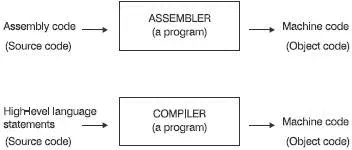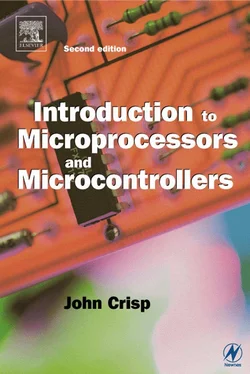John Crisp - Introduction to Microprocessors and Microcontrollers
Здесь есть возможность читать онлайн «John Crisp - Introduction to Microprocessors and Microcontrollers» весь текст электронной книги совершенно бесплатно (целиком полную версию без сокращений). В некоторых случаях можно слушать аудио, скачать через торрент в формате fb2 и присутствует краткое содержание. Год выпуска: 2004, ISBN: 2004, Издательство: Elsevier, Жанр: Компьютерное железо, на английском языке. Описание произведения, (предисловие) а так же отзывы посетителей доступны на портале библиотеки ЛибКат.
- Название:Introduction to Microprocessors and Microcontrollers
- Автор:
- Издательство:Elsevier
- Жанр:
- Год:2004
- ISBN:0-7506-5989-0
- Рейтинг книги:3 / 5. Голосов: 1
-
Избранное:Добавить в избранное
- Отзывы:
-
Ваша оценка:
- 60
- 1
- 2
- 3
- 4
- 5
Introduction to Microprocessors and Microcontrollers: краткое содержание, описание и аннотация
Предлагаем к чтению аннотацию, описание, краткое содержание или предисловие (зависит от того, что написал сам автор книги «Introduction to Microprocessors and Microcontrollers»). Если вы не нашли необходимую информацию о книге — напишите в комментариях, мы постараемся отыскать её.
Introduction to Microprocessors and Microcontrollers — читать онлайн бесплатно полную книгу (весь текст) целиком
Ниже представлен текст книги, разбитый по страницам. Система сохранения места последней прочитанной страницы, позволяет с удобством читать онлайн бесплатно книгу «Introduction to Microprocessors and Microcontrollers», без необходимости каждый раз заново искать на чём Вы остановились. Поставьте закладку, и сможете в любой момент перейти на страницу, на которой закончили чтение.
Интервал:
Закладка:
Nearly all microprocessor-based systems are designed to operate in this way and it seems so obvious that it is difficult to think that there is any alternative – but there is, as we will see later.
In each case, choose the best option.
1 An assembler:
(a) converts assembly programs into machine code.
(b) is a type of microprocessor.
(c) converts object code into machine code.
(d) is essential for converting mnemonics into source code.
2 The data that follows the op code:
(a) is always present and consists of one or more bytes.
(b) is called the object code.
(c) is called the operand.
(d) uses denary numbers.
3 A label is:
(a) an important feature in designer clothing.
(b) a form of syntax error.
(c) used to represent an address while the program is being written.
(d) the part of the program that comes before an operand.
4 Machine code is:
(a) not a low-level language.
(b) written using mnemonics.
(c) any language designed for controlling machinery in industry.
(d) an object code.
5 The part of the microprocessor that can follow the machine code is called the:
(a) Assembler.
(b) Instruction decoder.
(c) Instruction register.
(d) Mechanic.
10. High-level languages
The third-generation languages were intended to make life easier. They were designed to improve the readability by using English words which would make it easier to understand and to sort out any faults (bugs) in the program. The process of removing bugs is called debugging. In addition, they should relieve the programmer of any need to understand the internal architecture of the microprocessor and so the program should be totally portable. Ideally the programmer should not even need to know what processor is being used. These languages are called ‘high-level’ and are all procedural. Over the years, many languages have been invented just as there have been many microprocessors. Just like the microprocessors, a few languages had some special aptitude that made them stand out from the crowd. We will introduce some of the survivors.
In the early days of computers, they were seen as a means of improving the speed and accuracy of performing mathematical calculations – rather as new and improved calculating machines. IBM dominated the computer world at that time and employed John Backus to produce an improved language to supersede assembly language.
The result, finalized in 1957, was Fortran. This was the first high-level language to gain widespread acceptance. Its claim to fame was that it could evaluate mathematical formulas. This gave rise to its name ‘FORmula TRANslation’ (originally ‘IBM Mathematical Formula Translating System’). (See Figure 10.1.)

Figure 10.1 The first successful high-level language – and still going
Fortran has instructions built-in to handle most scientific formulas such as finding the sine of an angle which would be extremely difficult to do in assembly language. Difficult, but not impossible. After all, the Fortran program must first be converted into the machine code understood by the microprocessor. If the Fortran program can be converted to machine code, then it follows that the program could have been written in machine code in the first case. Its just a matter of saving an enormous amount of work.
As time went by, small additions and alterations were made to the language giving rise to new ‘dialects’. The disadvantage of this is that it starts to erode portability – one of the primary reasons for having a high-level language. In 1958 a re-defined language called Fortran 2 was born which was replaced in turn by Fortran 3 and 4. Still new dialects were sprouting and, in 1966, a final, last, definitive version called Fortran 66 was designed. Then we had the even more final and more definitive Fortran 77 and the absolutely final and totally definitive Fortran 90. This is not as bad as it seems since each new version included extras rather than changes. There was a Fortran 95 version and there is another due out somewhere around the year 2004 to 2006 which, at the moment, is just referred to as 200X but at least this name suggests a launch no later than the year 2009. In the meantime, an easily learnt version, simply called F, was launched. This was compatible with Fortran 77, 90 and 95 but includes some more modern characteristics while older more redundant sections were quietly dropped. High Performance Fortran (HPF) is similar to the 90 and 95 versions except that it has been extended to allow microprocessors to be run in parallel for extra speed.
Compilers
In assembly language, we used an assembler program to convert the mnemonics to machine code. We usually refer to the conversions being from source code to object code but it means the same thing. In Fortran, or any high-level language, we use a compiler to produce the machine code. The compiler will also carry out the useful extras like error and syntax checking that we met with the assemblers. Compilers and assemblers are both software – that is, they are programs designed to do a specific job. If we were using a 68000 microprocessor, and wished to program it using a particular language, say Fortran, then we would have to purchase a ‘Fortran 90 to 68000’ compiler. It would do just this job and nothing else. We could not adapt it in any way to accept a different high-level language or ‘target’ it at a different processor (see Figure 10.2).

Figure 10.2 Compilers are like assemblers
All assemblers are basically one-to-one converters. We enter the op code and out comes the object code so the only difference between two assemblers is in the amount of debugging and label handling help that it can provide. Compilers are different. There are not any direct object code equivalents to things like sine or square root so the final output depends on the skills of the compiler designer. The programmer must look at each of the available commands in the high level language and write an assembly program to perform the function. Some compilers are, therefore, inevitably better than others.
Libraries, linkers and loaders
When the designer has struggled through the process of devising assembly code for a particularly nasty formula it would make sense to store the answer away to allow its use on another occasion. A collection of these solutions is called a library and can be purchased.
This reduces the amount of totally original coding that is needed. Many ‘new’ formulas can be made from combinations of existing code. Slotting these ready-made library routines into the main programs is performed by a linker which is another piece of software. The linker therefore joins or links together many separate pieces of code into one program ready for use. The last job to be done is to load it into some RAM ready for use. Another piece of software is used to determine which addresses in the microprocessor system memory are available. This is called a loader. A loader also converts labels to their final addresses. Very often the linking and loading functions are combined into a single linker-loader program. The process is illustrated in Figure 10.3.

Figure 10.3 From high level to low level
Читать дальшеИнтервал:
Закладка:
Похожие книги на «Introduction to Microprocessors and Microcontrollers»
Представляем Вашему вниманию похожие книги на «Introduction to Microprocessors and Microcontrollers» списком для выбора. Мы отобрали схожую по названию и смыслу литературу в надежде предоставить читателям больше вариантов отыскать новые, интересные, ещё непрочитанные произведения.
Обсуждение, отзывы о книге «Introduction to Microprocessors and Microcontrollers» и просто собственные мнения читателей. Оставьте ваши комментарии, напишите, что Вы думаете о произведении, его смысле или главных героях. Укажите что конкретно понравилось, а что нет, и почему Вы так считаете.












